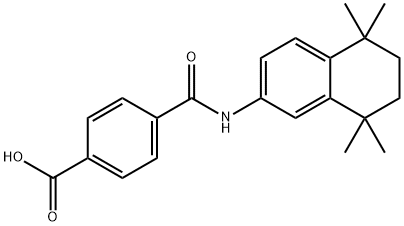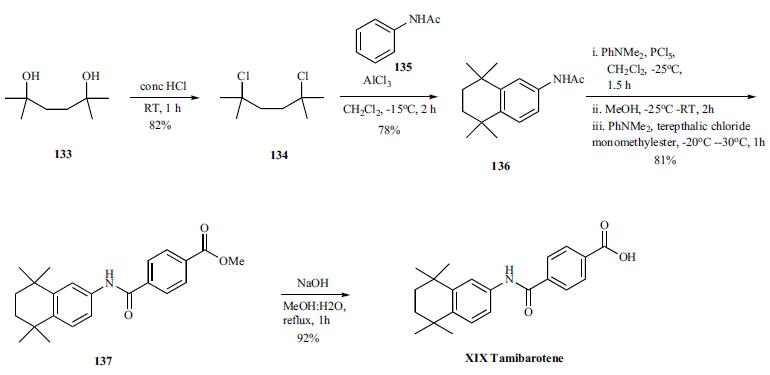|
ChemicalBook Optimization Suppliers |
|
| 化学名: | タミバロテン | | 英語化学名: | Tamibarotene | | 别名: | AM80;Tamibarotene;4-[(5,5,8,8-Tetramethyl-6,7-dihydronaphthalen-2-yl)carbamoyl]benzoic acid;4-[[(5,6,7,8-Tetrahydro-5,5,8,8-tetramethyl-2-naphthalenyl)amino]carbonyl]benzoic Acid;Am 80 (pharmaceutical);Amnolake;NSC 608000;Retinoid AM 80 | | CAS番号: | 94497-51-5 | | 分子式: | C22H25NO3 | | 分子量: | 351.44 | | EINECS: | 1806241-263-5 | | カテゴリ情報: | Inhibitors;Intermediates & Fine Chemicals;Pharmaceuticals;Retinoids | | Mol File: | 94497-51-5.mol |  |
| 融点 | 231-232°C | | 沸点 | 449.6±45.0 °C(Predicted) | | 比重(密度) | 1.154±0.06 g/cm3(Predicted) | | RTECS 番号 | DH6940000 | | 貯蔵温度 | room temp | | 溶解性 | Soluble to 50 mM in DMSO | | 外見 | powder | | 酸解離定数(Pka) | 3.83±0.10(Predicted) | | 色 | white to off-white |
| | タミバロテン Usage And Synthesis |
| 外観 | 白色, 結晶~粉末 | | 溶解性 | エタノール(95)にやや溶けやすく、アセトニトリルに溶けにくく、水にほとんど溶けない。 | | 用途 | レチノイドレセプターを介するさまざまな細胞内伝達ツール。 | | 効能 | 抗悪性腫瘍薬, レチノイン酸受容体(RAR)作動薬 | | 商品名 | アムノレイク (東光薬品工業) | | 説明 | AM80 is a retinoic acid receptor agonist that is selective for RARα (Kd = 62 nM; AC50 = 1.46 nM) compared to RARβ (Kd = 280 nM; AC50 = 6.87 nM) and RARγ (Kd = 816 nM; AC50 = 148.7 nM). It demonstrates greater specific binding to RARα compared to retinoic acid , which exhibits little selectivity across RARα, β, or γ. AM80 exhibits antiproliferative effects against acute promyelocytic leukemia cells, inducing human promyelocytic leukemia HL-60 cell differentiation with an ED50 value of 0.79 nM. It has also been shown to suppress the growth of other myeloid and lymphoid malignant cells. | | 説明 | Tamibarotene, a selective agonist of the retinoic acid receptor, was launched in
Japan as an oral treatment for relapsed or refractory acute promyelocytic
leukemia (APL). APL is a form of acute myeloid leukemia (AML) characterized by
a deficiency in mature blood cells and an excess of immature cells called promyelocytes
in the bone marrow and peripheral blood. The current standard of care
for APL includes treatment with all-trans-retinoic acid (ATRA), either alone or in
combination with chemotherapy. ATRA is a high affinity ligand for two types of
nuclear receptors, retinoic acid receptor (RAR) and retinoid X receptor (RXR),
each of which has three subtypes (-α, -β, and -γ). Activation of RARα by ATRA
causes promyelocytes to differentiate and mature, thereby inhibiting their proliferation
and inducing disease remission. Although ATRA is one of the most clinically
successful retinoids, its usage is hampered by the high rate of adverse effects,
instability, and the appearance of ATRA-resistant leukemia cells.Adverse events included retinoic acid syndrome, hyperleukocytosis, xerosis,
cheilitis, hypertriglyceridemia, and hypercholesterolemia; however, these side effects
were generally milder than with ATRA, which all patients had received previously.
Examination of human samples taken from Phase II and III clinical trials revealed
that fecal excretion was the major elimination route, and the metabolism of tamibarotene
occurred primarily through hydroxylation and taurine conjugation. In
vitro, the plasma protein binding of tamibarotene is shown to be >98% in rats,
dogs, and humans. Tamibarotene is synthesized from 5,5,8,8-tetramethyl-5,6,7,
8-tetrahydronaphthalene in a four-step sequence consisting of regioselective nitration
in the 2-position, reduction of the nitro group by hydrogenation to produce
the corresponding aniline derivative, acylation of the aniline intermediate with
4-(carbomethoxy)benzoyl chloride, and hydrolysis of the methyl ester. | | 化学的特性 | Crystalline Solid | | Originator | Toko Yakuhin Kogyo (Japan) | | 使用 | Tamibarotene, a retinoic acid receptor-α(RARα) agonist,
was approved for the treatment of relapsed or refractory
acute promyelocytic leukemia (APL) in Japan on June, 2005
and is currently marketed by Nippon Shinyaku Co. This
novel drug has shown high remission rate among patients
who have recurrent disease after all trans retinoic acid therapy. | | 使用 | A RARα agonist that induces differentiation and apoptosis | | 使用 | Synthetic retinoic acid receptor-α/β-selective retinoid. Antineoplastic. | | 使用 | Synthetic retinoic acid receptor-a/?selective retinoid. Antineoplastic | | 定義 | ChEBI: A dicarboxylic acid monoamide resulting from the condensation of one of the carboxy groups of terephthalic acid with the amino group of 5,5,8,8-tetramethyl-5,6,7,8-tetrahydronaphthalen-2-amine. | | brand name | Amnolake | | 生物活性 | Retinoic acid receptor α (RAR α ) agonist that induces differentiation (ED 50 = 0.79 nM) and apoptosis of HL-60 cells in vitro . Exhibits antiproliferative effects against a variety of human tumor cells lines (mean values of 35, 40 and 60% growth inhibition at 0.1, 1 and 10 μ M respectively) and displays anticancer activity against acute promyelocytic leukemia in vivo . | | Biochem/physiol Actions | Tamibarotene (Am80) is a RAR α agonist. Tamibarotene was developed to overcome resistance to ATRA and is currently approved in Japan for treatment of recurrent acute promyelocytic leukemia (APL). The compound induces HL-60 cells differentiation and apoptosis. Similarly to TTNPB, the compound neither binds to nor transactivates the RXRs. In contrast to TTNPB (pan RAR agonist), Tamibarotene is rather specific toward RAR α. The compound is approximate 10 times more potent than ATRA. | | 合成 | Several synthesis of tamibarotene have been disclosed
in the literature including the process scale synthesis
as shown in the scheme. The synthesis started
with preparation of dichloride 134 in 82% yield from diol
133 by treating with concentrated HCL in DCM. Friedal
Crafts reaction of dichloride 134 with acetanilide in the presence
of aluminum chloride at -15??C for 2h provided
acetanilide derivative 136 in 78% yield. In a single pot, the
acetanilide was reacted with PCl5 and dimethylaniline at -25??C for 1.5h followed by quenching the reaction with
methanol for 2h after addition at -25??C. Addition of dimethylaniline
and terepthalic chloride mono-methylester at -30 - -
20??C for 1 hr provided the tamibarotene methyl easter 137 in
81% yield. Hydrolysis of the ester by heating with sodium
hydroxide in MeOH:water mixture for 1h followed isolation
and crystallization gave tamibarotene (XIX) in 92% yield. 
| | 貯蔵 | Store at RT |
|